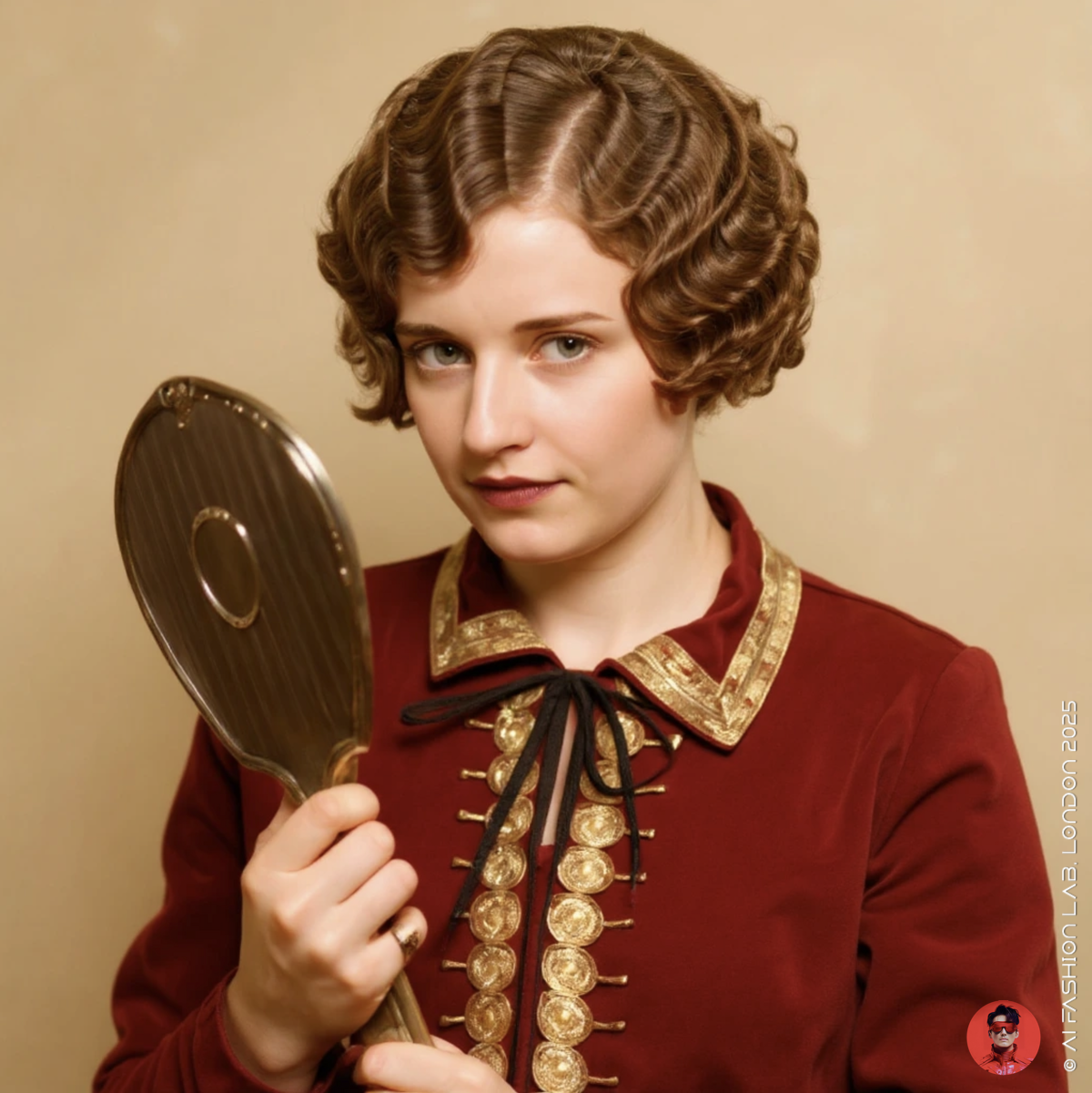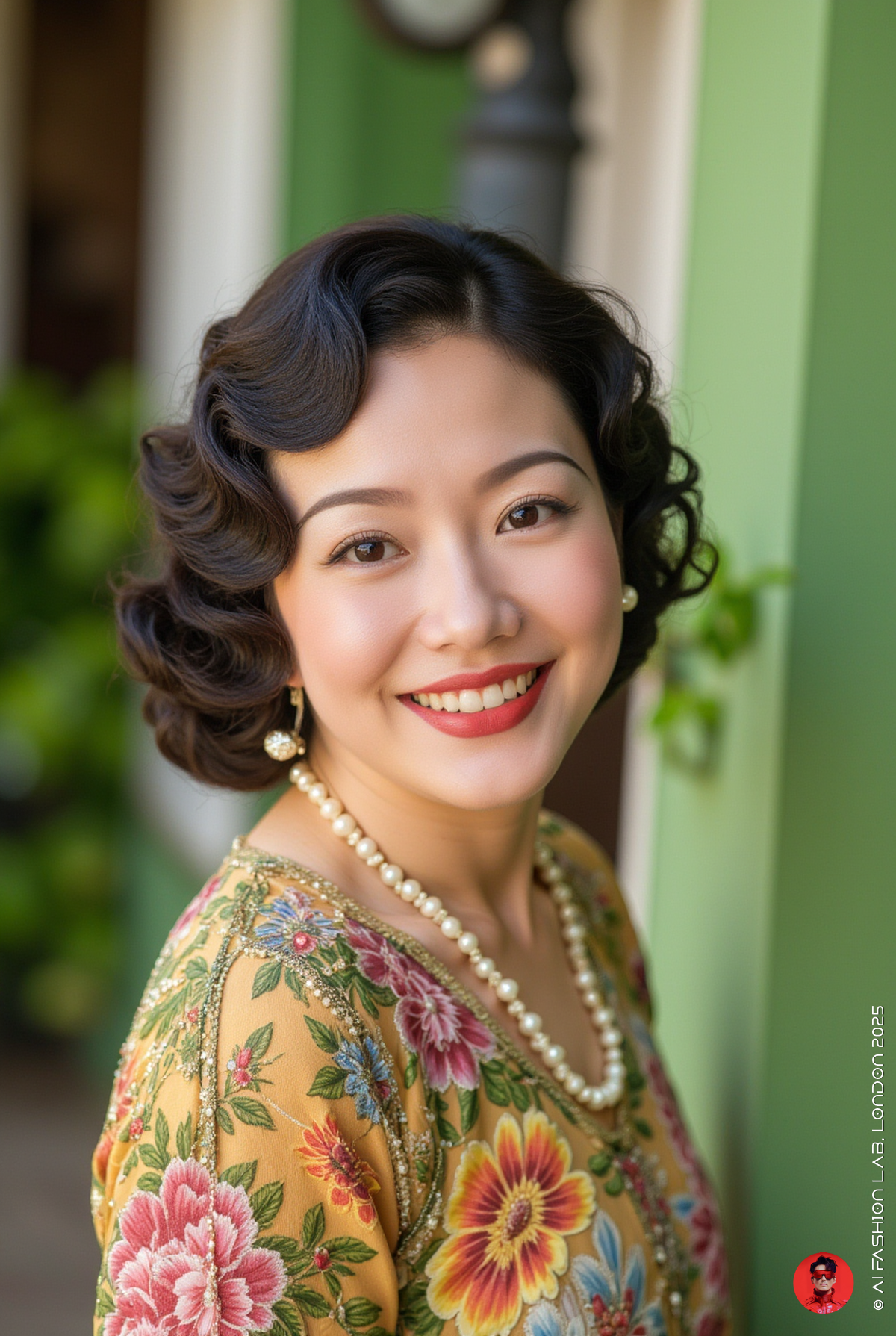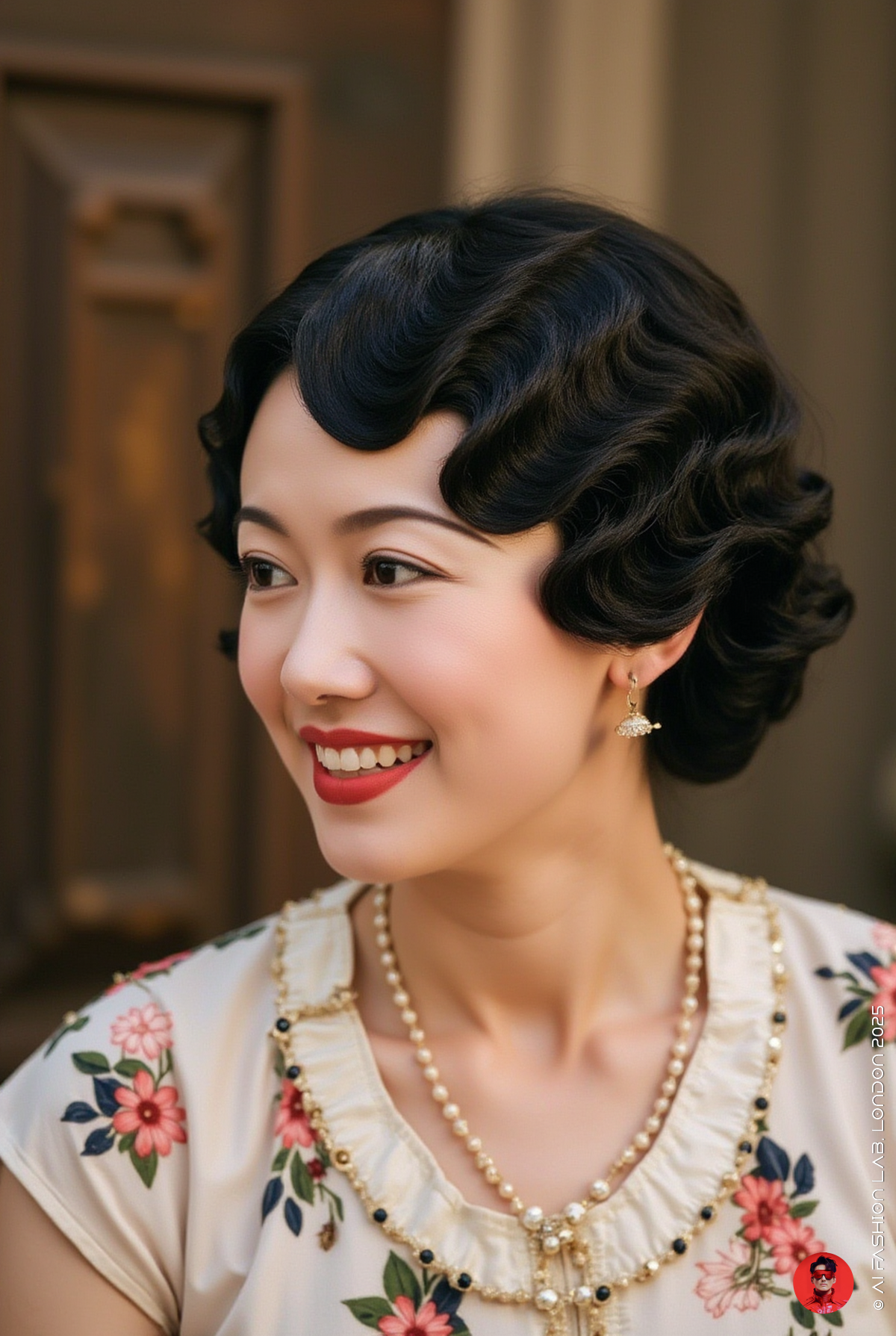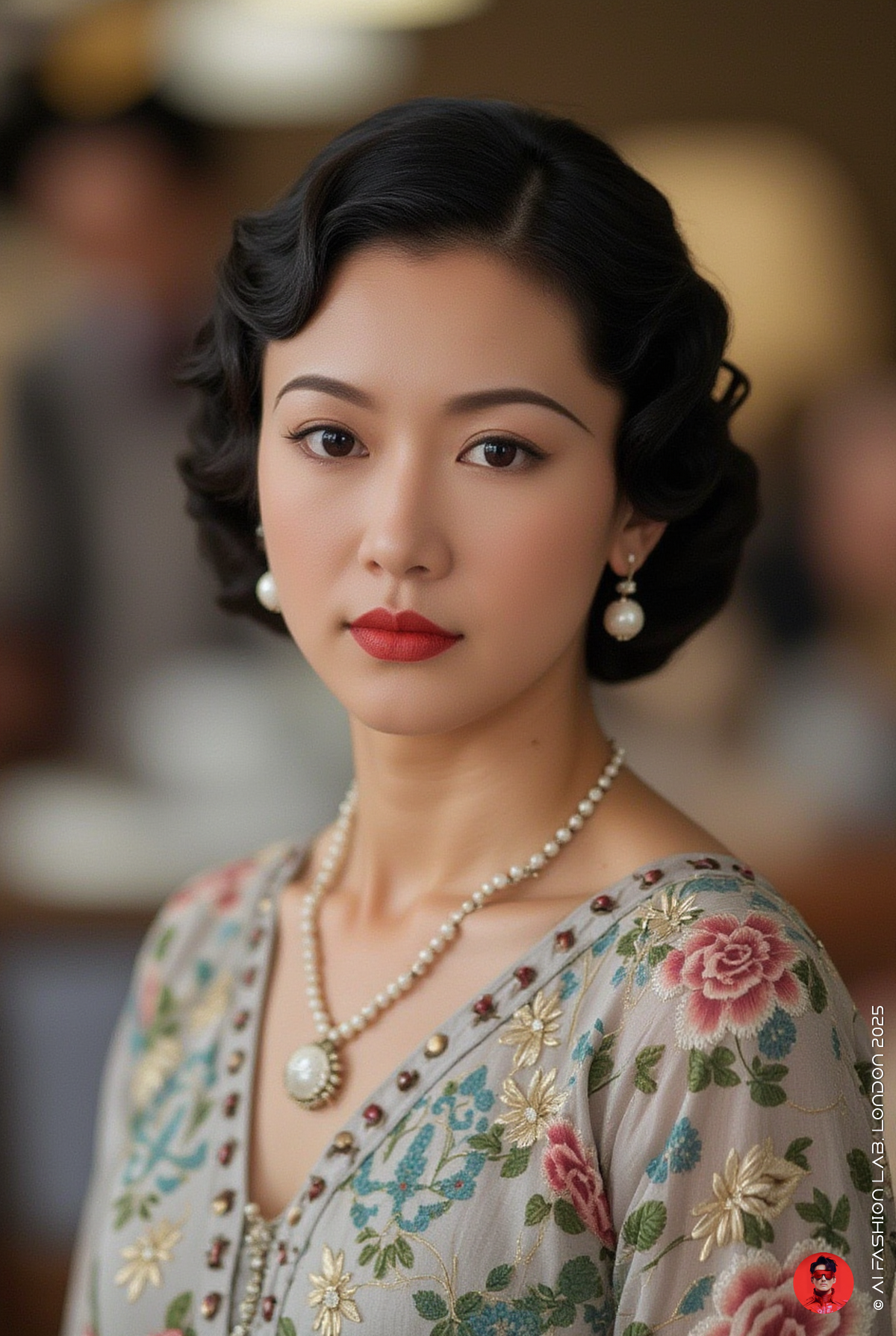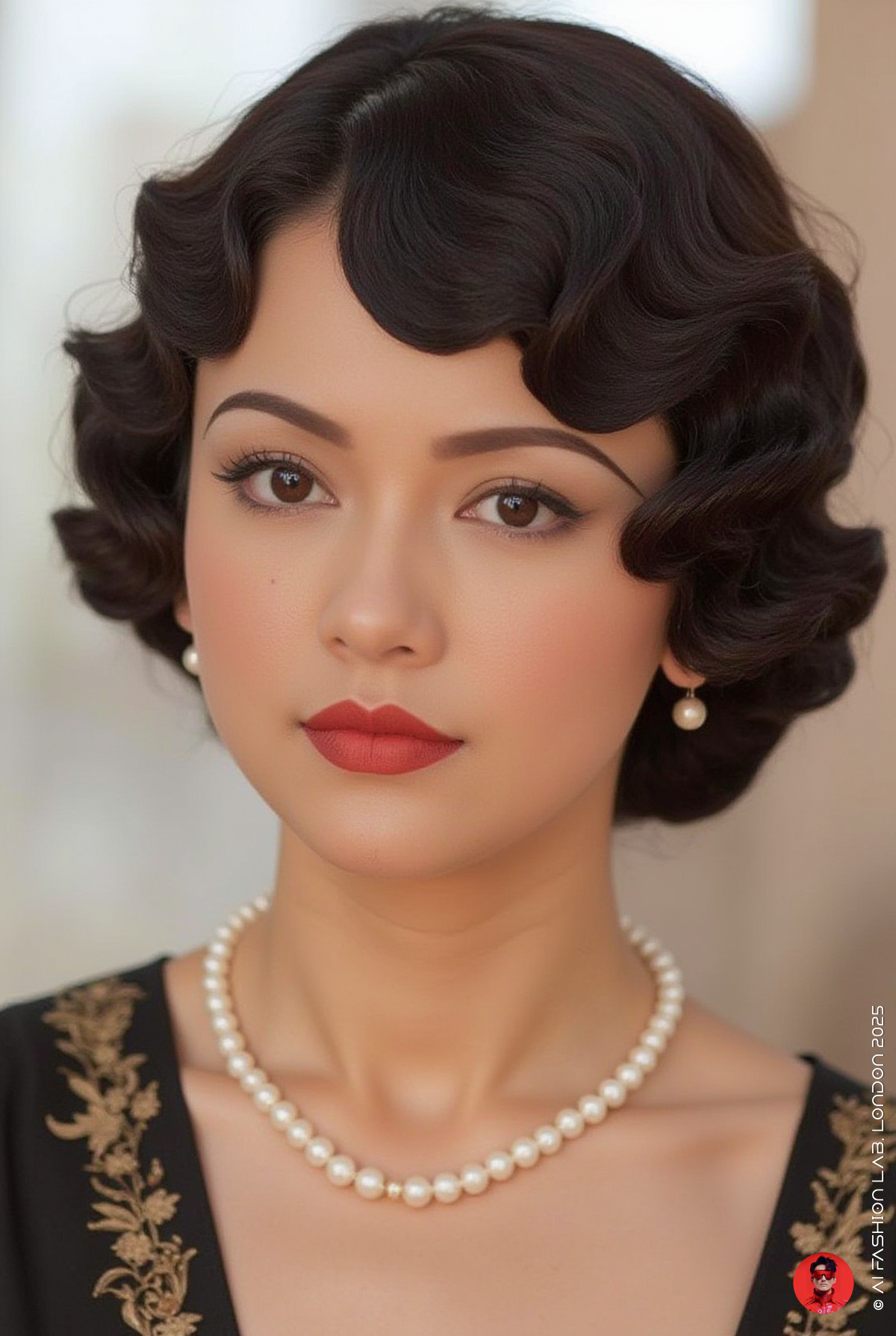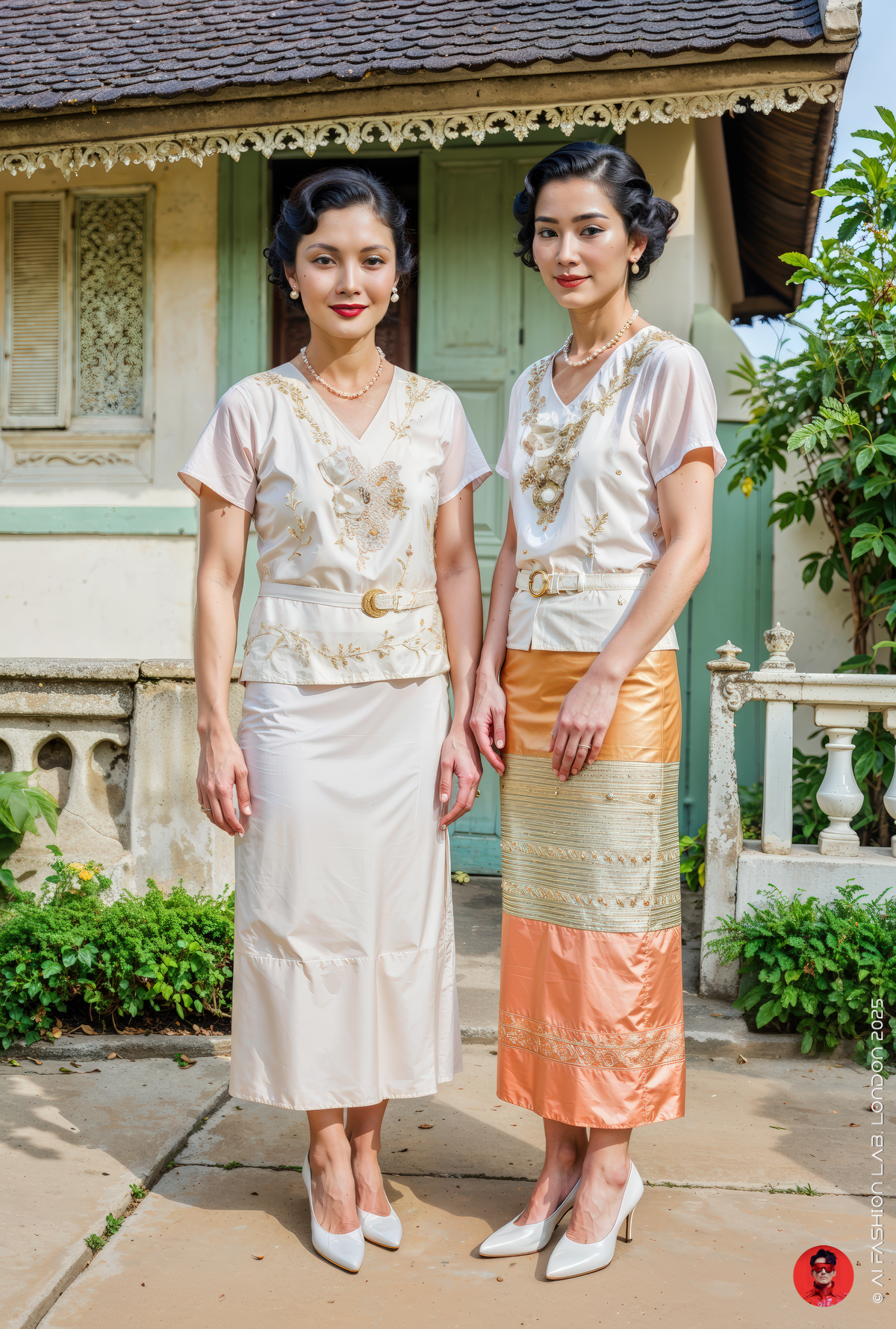ทรงผมสตรี ทรงปันหยี และการแต่งหน้าในยุครัชกาลที่ ๗ (พ.ศ. ๒๔๖๘–๒๔๗๕)
ทรงผมสตรี ทรงปันหยี และการแต่งหน้าในยุครัชกาลที่ ๗ (พ.ศ. ๒๔๖๘–๒๔๗๕)
ช่วงรัชสมัยพระบาทสมเด็จพระปกเกล้าเจ้าอยู่หัว (พ.ศ. ๒๔๖๘–๒๔๗๕) ตรงกับปลายทศวรรษ 1920 ถึงต้นทศวรรษ 1930 ซึ่งนับเป็นช่วงหัวเลี้ยวหัวต่อของแฟชั่นสมัยใหม่ ที่เปลี่ยนผ่านจากยุคอาร์ตเดโค (Art Deco) ไปสู่ยุค “สตรีมไลน์ โมเดิร์นนิสม์” (Streamlined Modernism) และ “ฮอลลีวูด แกลมเมอร์” (Hollywood Glamour) อันโดดเด่นด้วยเส้นสายอ่อนช้อยและสัดส่วนที่เน้นความเฟมินีนอย่างสง่างามในยุคภาวะเศรษฐกิจตกต่ำ (The Great Depression) ต้นทศวรรษ 1930
แม้โครงร่างของเสื้อผ้าจะเปลี่ยนแปลงไปอย่างชัดเจน—ตั้งแต่ชุดทรงตรงแบบเอวต่ำของยุค 1920 ไปสู่ชุดเข้ารูปที่เน้นเส้นโค้งเว้าของร่างกาย มีการตัดเย็บแบบเฉียง (bias-cut) เพื่อสร้างการเคลื่อนไหวพลิ้วไหวและเข้ารูปกระชับกับสัดส่วน และกระโปรงยาวระดับกลางหน้าแข้ง (midi length) ที่พลิ้วบางแต่สง่า—แต่สไตล์ของทรงผมแบบ Marcel waves และ finger waves และการแต่งหน้าที่เน้นดวงตาคมชัดกับริมฝีปากสีเข้มยังคงได้รับความนิยมต่อเนื่องในหมู่สตรีชั้นสูง ผู้มีความทันสมัยในช่วงปลายรัชกาลที่ ๗
แรงบันดาลใจด้านแฟชั่นในยุคนี้มักได้รับอิทธิพลจากดาราฮอลลีวูดอย่าง Jean Harlow, Marlene Dietrich, และ Greta Garbo ซึ่งปรากฏตัวในภาพยนตร์ด้วยเดรสผ้าซาตินเนื้อลื่นแบบ bias-cut คอเว้าแบบ cowl neckline หรือโชว์ไหล่บางส่วนอย่างมีชั้นเชิง กลายเป็นภาพแทนของสตรีสมัยใหม่ที่สง่างามแต่เปราะบางในคราวเดียวกัน
สำหรับคอลเลกชันนี้ ผมออกแบบให้มีเอกลักษณ์ความเป็นไทยร่วมสมัย โดยผสมผสานเสื้อเบลาส์ชายยาวแบบตะวันตกเข้ากับผ้าซิ่นไทย เพื่อสร้างลวงตาให้ระดับเอวต่ำลงมาถึงสะโพก ซึ่งเป็นเส้นโครงหลักของแฟชั่นยุค 1920 อันสอดคล้องกับแนวทางการปรับใช้แฟชั่นตะวันตกในสยามขณะนั้น
ทรงผมลอนมาเซล (Marcel Wave): เอกลักษณ์แห่งยุคฟลัปเปอร์
หนึ่งในทรงผมที่โดดเด่นที่สุดของช่วงเวลาดังกล่าว คือ ลอนมาเซล (Marcel Wave) หรือที่เรียกในภาษาไทยว่า “ทรงปันหยี”เป็นลอนที่แนบชิดศีรษะ มีความโค้งต่อเนื่องคล้ายคลื่นทะเล เรียบหรูและดูมีจังหวะอย่างมีศิลปะ แตกต่างจาก finger wave ตรงที่ลอนมีขนาดใหญ่กว่าและมีโครงสร้างที่ชัดเจนยิ่งกว่า โดยเฉพาะเมื่อจัดแต่งร่วมกับทรงผมบ๊อบซึ่งกำลังเป็นที่นิยมในสมัยนั้น
ลักษณะเด่นของทรงผมลอนมาเซล:
เทคนิค: ใช้ที่หนีบผมโลหะร้อนแบบโบราณ เรียกว่า Marcel iron ซึ่งควบคุมด้วยมือ (ยังไม่มีระบบสปริงหรือไฟฟ้าเหมือนเครื่องหนีบผมยุคปัจจุบัน)
รูปลักษณ์: ลอนโค้งแนบศีรษะ เรียบลื่นต่อเนื่อง สื่อถึงความประณีตแบบอาร์ตเดโค
บริบททางประวัติศาสตร์: เป็นทรงยอดนิยมในหมู่สาวฟลัปเปอร์ และนักแสดงหญิงระดับนานาชาติ
บุคคลสำคัญ: นักแสดงชาวอเมริกัน Josephine Baker มักปรากฏตัวพร้อมลอนมาเซลและเครื่องแต่งกายสะดุดตา
การประยุกต์ในปัจจุบัน: มีการนำมาใช้ควบคู่กับ finger wave เพื่อสร้างลุควินเทจที่อ่อนหวานและดูร่วมสมัยมากขึ้น
สำหรับสตรีที่ไว้ผมยาวในยุคนั้น ก็มักจะรวบผมไว้ที่ท้ายทอยแล้วเกล้าหรือประดับกิ๊บด้านข้างศีรษะ เพื่อให้แลดูสุภาพ เรียบร้อย และสง่างาม
ทรงผมนี้มีต้นกำเนิดจากช่างผมชาวฝรั่งเศสชื่อ Marcel Grateau ซึ่งพัฒนาเทคนิคการดัดลอนมาตั้งแต่ปี ค.ศ. 1870 ต่อมาเขาอพยพไปยังสหรัฐอเมริกาและเปลี่ยนชื่อเป็น François Marcel Woelfflé โดยจดสิทธิบัตรเกี่ยวกับอุปกรณ์ดัดผมในปี 1905 และ 1918
การแต่งหน้า: ลุคตุ๊กตาวินเทจ (Vintage Doll Look)
การแต่งหน้าในช่วงทศวรรษ 1920–1930 โดดเด่นไม่แพ้ทรงผม โดยเน้นการสร้างลุคแบบ ตุ๊กตาพอร์ซเลน ซึ่งสะท้อนถึงความเย้ายวนและความกล้าหาญของสตรียุคใหม่
คิ้ว:
กันให้บางที่สุด แล้ววาดใหม่ให้มีเส้นโค้งชัด
นิยมวาดโค้งต่ำลงเพื่อให้ใบหน้าดูหวาน เศร้า และมีเสน่ห์
ดวงตา:
ใช้ดินสอเขียนขอบตาบนและล่างอย่างชัดเจน
ปัดมาสคาร่าเข้มเพื่อเพิ่มความลึกและดราม่าให้ดวงตา
ริมฝีปาก:
วาดทรงปากให้เด่นชัด โดยเฉพาะบริเวณ Cupid’s Bow
ใช้ลิปสติกสีแดงเข้มหรือสีพลัม ซึ่งได้รับความนิยมอย่างมากในยุคนั้น
ลุคนี้กลายเป็นซิกเนเจอร์ของผู้หญิงยุคฟลัปเปอร์—ผู้กล้าคิด กล้าแสดงออก และมีเสรีภาพในการนิยามความงามด้วยตนเอง สะท้อนภาพของสตรีไทยบางกลุ่มในยุครัชกาลที่ ๗ ที่เริ่มหันมาสนใจแฟชั่นตะวันตกมากขึ้น โดยเฉพาะในราชสำนักฝ่ายใน และแวดวงสตรีชนชั้นสูง และสตรีในสังคมเมืองหลวง
Women’s Hairstyles, the “Pan-Yi” Marcel Wave, and Makeup in the Reign of King Prajadhipok (1925–1932)
During the reign of King Prajadhipok (r. 1925–1935), Thailand experienced a turning point in modern fashion, corresponding to the late 1920s and early 1930s—a period of transition from the Art Deco era to what became known as “Streamlined Modernism” and “Hollywood Glamour.” This new aesthetic was characterised by softer lines and elegant silhouettes that celebrated feminine curves during the early years of the Great Depression.
Although the overall silhouette of women's clothing underwent a dramatic transformation—from the low-waisted, straight-cut dresses of the 1920s to more figure-hugging garments that emphasised curves through the use of bias-cut techniques, allowing for fluid movement and a close fit, paired with graceful midi-length skirts—the hairstyles and makeup of the 1920s remained popular. Marcel waves and finger waves continued to frame the faces of high-society women, while bold eye makeup and dark lipstick retained their appeal among the fashion-forward elite during the final years of King Prajadhipok’s reign.
Fashion during this era drew significant inspiration from Hollywood film stars such as Jean Harlow, Marlene Dietrich, and Greta Garbo. These icons appeared on screen in lustrous satin gowns cut on the bias, with cowl necklines or artfully exposed shoulders—embodying the modern woman who was at once glamorous and delicately vulnerable.
For this collection, I sought to blend traditional Thai elements with contemporary Western influences. I designed Western-style long blouses paired with Thai tube skirts (pha sin), creating a visual illusion of a dropped waist that extended down to the hips. This silhouette echoed the iconic fashion line of the 1920s and reflected the gradual adaptation of Western fashion within Siam at the time.
The Marcel Wave (“Pan-Yi” Style): A Defining Flapper-Era Hairstyle
One of the most iconic hairstyles of this period was the Marcel Wave, known in Thai as “Song Pan-Yi”. This style featured soft, sculpted waves that lay flat against the head in a fluid, continuous pattern—resembling gentle sea waves. It was elegant, rhythmic, and refined, differing from the more tightly structured finger waves in both scale and definition. The Marcel Wave was particularly striking when paired with the fashionable bob haircut, which had become widespread among stylish women of the time.
Key Characteristics of the Marcel Wave:
Technique: Created using a manually controlled heated metal curling iron known as a Marcel iron—a precursor to modern curling tools, which lacked springs or electric heating elements.
Appearance: Smooth, flowing S-shaped waves clung close to the head, evoking the meticulous artistry of the Art Deco movement.
Historical Context: Popular among flapper girls and international film actresses alike, symbolising modern glamour and bold femininity.
Notable Figures: American entertainer Josephine Baker frequently wore her hair in a Marcel Wave, often paired with her dramatic stage costumes.
Contemporary Application: Today, the Marcel Wave is often revived in combination with finger waves to create a softer, more romantic vintage look.
For women who retained long hair in that era, it was common to twist the hair into a neat bun at the nape or secure it with decorative clips above the ear—presenting a look that was modest, graceful, and composed.
The technique was developed by Marcel Grateau, a French hairdresser who began experimenting with heated curling in the 1870s. He later emigrated to the United States and adopted the name François Marcel Woelfflé, eventually patenting his hair-styling device in 1905 and again in 1918.
Makeup: The Vintage Doll Look
Makeup during the 1920s and 1930s was no less remarkable than the hairstyles. The beauty ideal of the era embraced what is now known as the “Vintage Doll Look”, characterised by porcelain-like skin and dramatically accentuated features. This aesthetic reflected a new kind of femininity—seductive, daring, and self-defined.
Eyebrows:
Heavily plucked and redrawn into exaggerated arches.
Often curved downward to create a sorrowful yet alluring expression.
Eyes:
Outlined boldly with kohl or eyeliner on both upper and lower lids.
Thick mascara was applied to enhance the depth and drama of the gaze.
Lips:
Carefully drawn into a small, well-defined cupid’s bow.
Dark red and plum tones were favoured, adding to the theatrical effect.
This look became a signature of the Flapper movement—symbolising women who were unafraid to express themselves, challenge convention, and reclaim their image of beauty. In Siam, it resonated with certain segments of urban women, particularly those in the royal court, the diplomatic sphere, and among the elite circles of Bangkok. It marked a significant moment when Thai women began engaging more openly with Western fashion and redefining femininity in their own terms.
#aifashionlab #AI #aiartist #aiart #aifashion #aifashiondesign #aifashionstyling #aifashiondesigner #fashion #fashionhistory #historyoffashion #fashionstyling #fashionphotography #digitalfashion #digitalfashiondesign #digitalcostumedesign #digitaldesign #digitalaiart #ThaiFashionHistory #ThaiFashionAI #thailand #UNESCO














